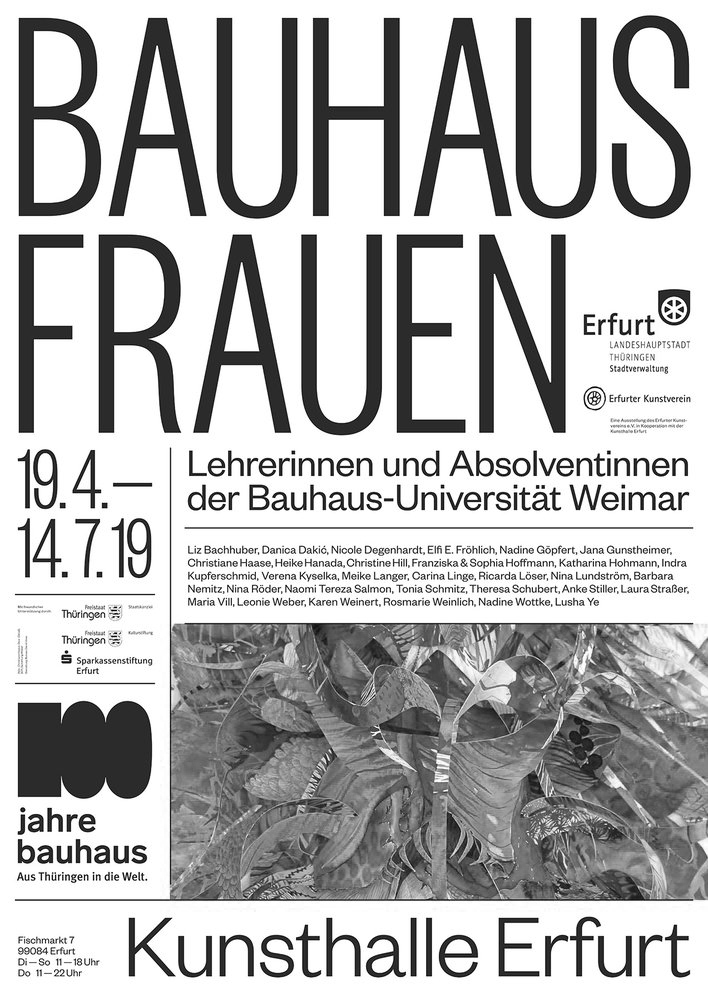Something it seemed that the women at the Bauhaus of the Weimar Republic could only achieve in the face of great resistance, namely being educated as self-reliant, aesthetically and economically independent female figures, designers and free artists, is now part of the modern, gender-equal education provided at the Bauhaus-Universität Weimar. So, under Germany’s socioeconomic conditions, shouldn’t female graduates find it easier than the female members of the historic Bauhaus to put their own visions of self-realisation via art and design activities into sustainable practice?
To examine this question, thirty works of art created by female professors, lecturers, researchers, and graduates of the Bauhaus-Universität Weimar (primarily from the Fine Art course at the Faculty of Art and Design) were selected for presentation in an exhibition. Their work represents a situation where women’s artistic self-expression is considered a matter of course, and where equitable development structures for people of both genders are part of the principles legally enshrined in government action, even if practice still leaves something to be desired.
Therefore, the diverse, high-quality, often astonishing pieces of evidence of aesthetic creativity on show in this exhibition are not being put on display because the organisers believe that their female connotations are what makes them special. No, they are special because they are significant in terms of their design and content, because they offer something innovative, unique, surprising, confusing, narrative, thoughtful, playful, ironic, brilliantly artisan, or exceptionally practical in their perspectives on our world, because in their nature as a designed shape and shaped idea or presentation, they convince with both their ambivalence and their stringency – and perhaps only rarely offer something that could genuinely be labelled as feminine (in terms of thought, feeling or shape). They are therefore good form and good art in the best sense, without any particular gender attributions, even if they do touch on gender themes.
This is now considered a matter of course, which is a good sign, as it was not the case a hundred years ago. The exhibition’s selection therefore also functions as a mirror, a form of rear-view mirror showing us how different today’s situation is to just a hundred years (and yet worlds) ago – and how much has been achieved since then, even if things are not yet entirely satisfactory for talented women in the modern art scene.
(Kunsthalle Erfurt announcement)
Preview:
Thursday 18 April 2019, 6 pm
Exhibition period:
19 April to 14 July 2019
Exhibition venue:
Kunsthalle Erfurt
Fischmarkt 7
99084 Erfurt
Accompanying programme
Events
5 May, 3 pm
Border Patrol and Border Crossers
Crochet meet with Granny Squares, Nina Lundström
8 May, 7 p.m.
Equal opportunities? Female artists today
Panel discussion with Liz Bachhuber, Verena Krieger, Carina Linge, Larissa Kikol, Kristian Jarmuschek
Presenters: Susanne Knorr and Kai Uwe Schierz
Long Night of Museums on 17 May, 6 pm- 12 am
6:30 pm and 7 pm
Brief tours by the curators
Bauhaus-Universität Weimar scouts will be on hand as points of contact for the evening.
29 May, 7 pm
Screening 1
Verena Kyselka (video artist & performer, Berlin)
5 June, 7 pm
Screening 2
Nina Lundström (video artist, Weimar)
Tours
Thursdays 7 pm
25 April, 9 May, 23 May, 6 June, 20 June, 4 July
Sundays 11:15 am
5 May, 19 May, 2 June, 16 June, 30 June, 14 July
Exhibiting artists:
Liz Bachhuber, Danica Dakić, Nicole Degenhardt, Elfi E. Fröhlich, Nadine Göpfert, Jana Gunstheimer, Christiane Haase, Heike Hanada, Christine Hill, Franziska & Sophia Hoffmann, Katharina Hohmann, Indra Kupferschmid, Verena Kyselka, Meike Langer, Carina Linge, Ricarda Löser, Nina Lundström, Barbara Nemitz, Nina Röder, Naomi Tereza Salmon, Tonia Schmitz, Theresa Schubert, Anke Stiller, Laura Straßer, Maria Vill, Leonie Weber, Karen Weinert, Rosmarie Weinlich, Nadine Wottke, Lusha Ye
